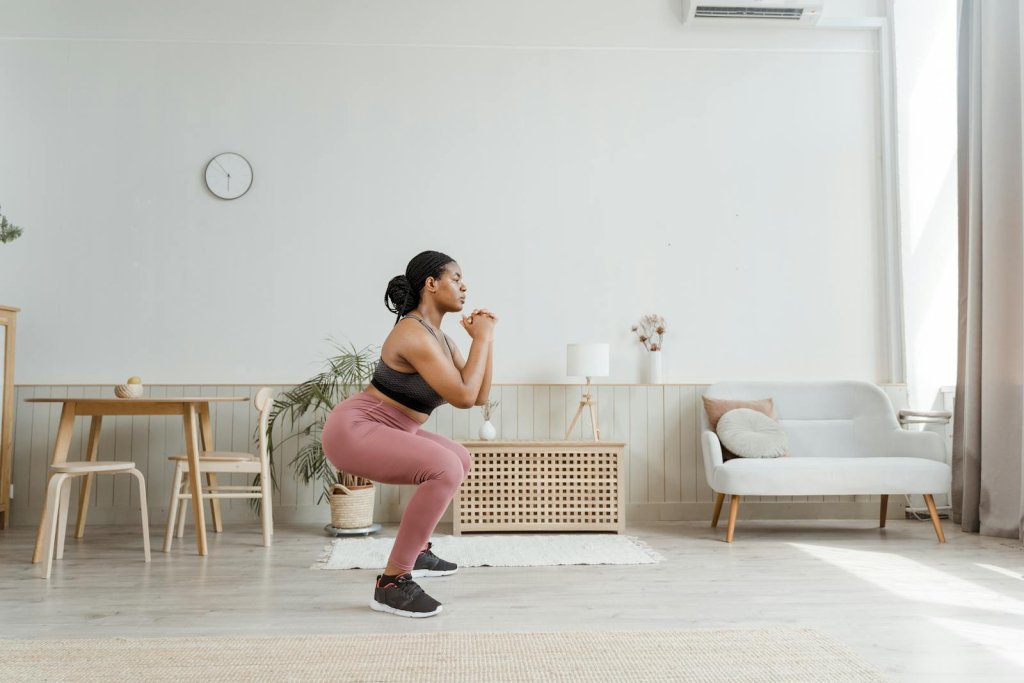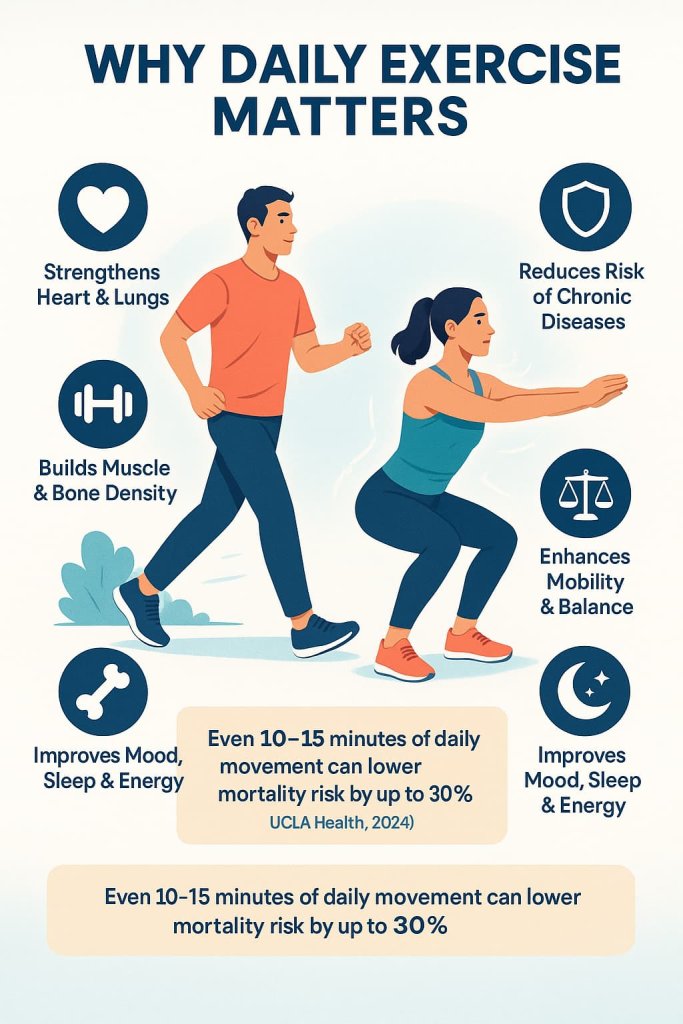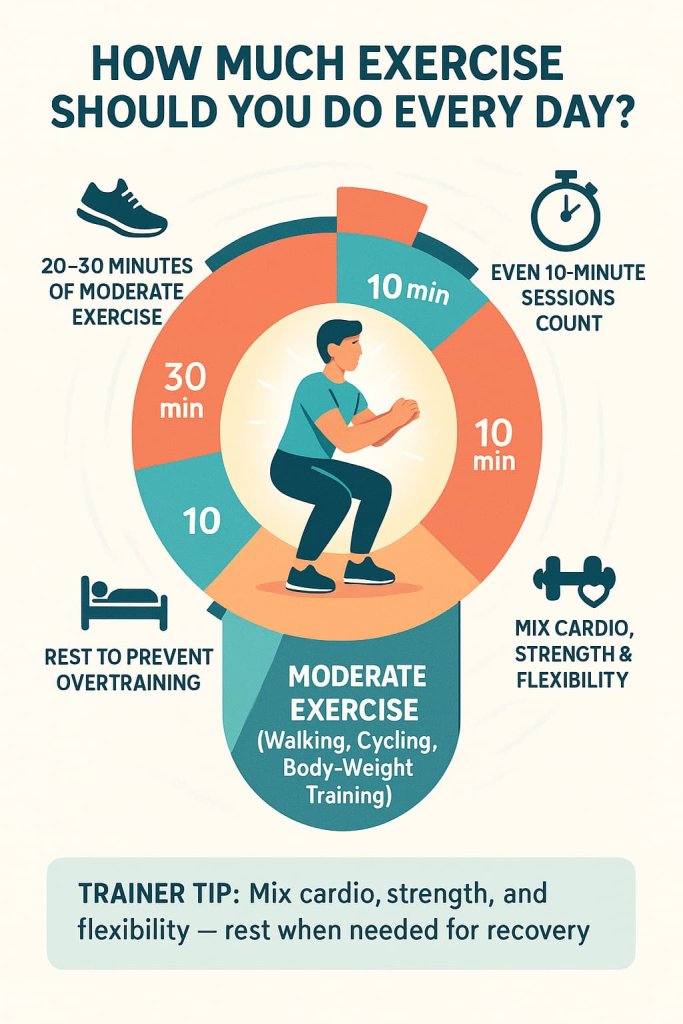The best exercise to do every day is the one that combines movement, strength, and balance — such as walking, squats, planks, and pushups — because they engage multiple muscles, boost heart health, and can be done anywhere.

Daily exercise isn’t about intensity; it’s about consistency. Just 10–30 minutes of smart movement each day improves strength, posture, flexibility, and longevity. Understanding which exercises give the most return for your effort helps you stay strong, pain-free, and energized for life.
According to the World Health Organization (2024) and Harvard Health (2025), adults should aim for at least 150 minutes of moderate activity per week — or about 30 minutes a day — for optimal health. Doing simple, full-body exercises daily ensures you meet that goal without needing a gym or fancy equipment.
Why Daily Exercise Matters
Research from the Mayo Clinic (2024) and National Institutes of Health (2024) confirms that consistent physical activity:

- Strengthens heart and lungs
- Reduces risk of chronic diseases like diabetes, obesity, and hypertension
- Builds muscle and bone density
- Improves mood, sleep, and energy
- Enhances mobility and balance
Even brief daily workouts — such as 10–15 minutes — can reduce mortality risk by up to 30% (UCLA Health, 2024). The key is moving consistently, not pushing to exhaustion.
How Much Exercise Should You Do Every Day
Most experts, including the World Health Organization (2025) and Mayo Clinic (2024), recommend at least 20–30 minutes of moderate exercise daily — such as brisk walking, cycling, or body-weight training.
Even short sessions of 10 minutes count if done consistently.

Trainer Tip:
Mix cardio, strength, and flexibility throughout the week for best results — and rest when needed to prevent overtraining.
15 Best Exercises to Do Every Day
Below are the 15 most effective, research-supported exercises for daily practice. Each targets multiple muscle groups and supports strength, mobility, and overall fitness.
1. Walking
Why it works:
Walking strengthens your heart, burns fat, improves blood circulation, and boosts mood. Studies by the American Heart Association (2024) show brisk walking 30 minutes daily lowers heart-disease risk by 40%.
Muscles worked:
Quadriceps, hamstrings, calves, glutes, and core stabilizers.
How to do it:
- Stand tall with relaxed shoulders and engage your core.
- Walk briskly at a pace that raises your heart rate but allows conversation.
- Swing arms naturally and keep steps light and even.
- Aim for 30 minutes daily or split into 3 × 10-minute sessions.
Trainer Tip:
Add hills or light hand weights weekly for progression.
2. Squats
Why it works:
Squats build lower-body and core strength, enhance mobility, and improve posture.
Muscles worked:
Glutes, quadriceps, hamstrings, and lower back.
How to do it:
- Stand with feet shoulder-width apart, toes slightly out.
- Keep chest lifted and back neutral.
- Bend knees and hips, lowering as if sitting into a chair.
- Go as low as comfortable, then push through heels to stand tall.
Trainer Tip:
Push knees slightly outward and keep heels grounded to protect joints.
3. Push-Ups
Why it works:
Boosts upper-body strength and engages core without equipment.
Muscles worked:
Chest, shoulders, triceps, and abdominals.
How to do it:
- Begin in plank with hands slightly wider than shoulders.
- Engage core and keep body straight from head to heels.
- Lower chest nearly to floor.
- Push through palms to return to start.
Trainer Tip:
Modify on knees or an incline if needed; focus on controlled reps.
4. Plank
Why it works:
Strengthens deep core muscles, stabilizes spine, and improves posture.
Muscles worked:
Core, shoulders, back, and glutes.
How to do it:
- Start in forearm plank with elbows under shoulders.
- Engage abs and squeeze glutes.
- Keep body straight from head to heels.
- Hold 30–60 seconds while breathing steadily.
Trainer Tip:
Don’t let hips sag — quality over duration.
5. Glute Bridge
Why it works:
Activates glutes and hamstrings, reducing back strain and improving hip strength.
Muscles worked:
Glutes, hamstrings, and lower back.
How to do it:
- Lie on back, knees bent, feet hip-width apart.
- Engage core and press through heels.
- Lift hips until body forms a straight line from shoulders to knees.
- Pause 1–2 seconds, then lower slowly.
Trainer Tip:
Squeeze glutes at the top for maximum activation.
6. Lunges
Why it works:
Improves lower-body power, balance, and coordination.
Muscles worked:
Quads, glutes, hamstrings, and calves.
How to do it:
- Stand tall with feet hip-width apart.
- Step one leg forward and lower until both knees form 90° angles.
- Push through front heel to return to standing.
- Repeat on opposite leg.
Trainer Tip:
Keep chest upright and front knee behind toes.
7. Jumping Jacks
Why it works:
Boosts heart rate, burns calories, and improves coordination.
Muscles worked:
Shoulders, calves, glutes, and core.
How to do it:
- Stand with feet together, arms at sides.
- Jump feet out as arms swing overhead.
- Return to starting position and repeat rhythmically.
- Continue 30–60 seconds.
Trainer Tip:
Land softly on mid-foot to reduce impact.
8. Mountain Climbers
Why it works:
Combines cardio and strength for full-body endurance.
Muscles worked:
Core, shoulders, triceps, quads, and hip flexors.
How to do it:
- Begin in plank with arms straight.
- Drive one knee toward chest, then quickly switch legs.
- Maintain steady breathing and pace.
- Continue 20–40 seconds.
Trainer Tip:
Keep hips level — avoid bouncing or arching back.
9. Yoga Poses (Downward Dog, Child’s Pose, Cat-Cow)
Why it works:
Improves flexibility, joint health, and reduces stress.
Muscles worked:
Core, hamstrings, shoulders, and spine stabilizers.
How to do it:
- Start on all fours for Cat-Cow: alternate arching and rounding your spine.
- Move into Downward Dog: lift hips, straighten legs, press heels gently down.
- Finish with Child’s Pose for relaxation.
Trainer Tip:
Sync movement with deep, steady breathing.
10. Bicycle Crunch
Why it works:
Targets entire core and improves rotational strength.
Muscles worked:
Rectus abdominis, obliques, and hip flexors.
How to do it:
- Lie on back, hands behind head, legs lifted.
- Bring one knee toward chest as opposite elbow rotates to meet it.
- Alternate sides in pedaling motion.
- Keep lower back pressed into floor.
Trainer Tip:
Move slowly for muscle control — avoid pulling on neck.
11. Shoulder Rolls
Why it works:
Releases upper-body tension and improves posture.
Muscles worked:
Deltoids, trapezius, and rhomboids.
How to do it:
- Stand tall with relaxed arms.
- Roll shoulders forward in slow circles × 10 reps.
- Reverse direction backward × 10 reps.
Trainer Tip:
Combine with deep breathing to relieve stiffness.
12. Side Plank
Why it works:
Strengthens obliques and improves lateral stability.
Muscles worked:
Obliques, glutes, and shoulders.
How to do it:
- Lie on one side, legs extended.
- Prop forearm under shoulder and lift hips.
- Hold 20–45 seconds per side.
- Keep body in straight line.
Trainer Tip:
Modify by bending bottom knee for extra support.
13. Step-Ups
Why it works:
Enhances leg strength, balance, and cardiovascular endurance.
Muscles worked:
Glutes, quadriceps, hamstrings, and calves.
How to do it:
- Stand facing sturdy step or bench.
- Step up with one foot, press through heel to lift body.
- Step down carefully and alternate legs.
- Perform 10–15 reps each leg.
Trainer Tip:
Avoid pushing off trailing leg — let leading leg do the work.
14. Stretching Routine
Why it works:
Increases flexibility, reduces soreness, and prevents injury.
Muscles worked:
Full-body — hamstrings, hip flexors, calves, shoulders, and back.
How to do it:
- Stretch after exercise when muscles are warm.
- Hold each position 20–30 seconds.
- Focus on deep, steady breathing.
- Cover all major muscle groups.
Trainer Tip:
Move slowly; stretching should never cause pain.
15. Deep Breathing or Mindful Movement
Why it works:
Calms nervous system, lowers cortisol, and enhances focus.
Muscles worked:
Diaphragm, intercostals, and core stabilizers.
How to do it:
- Sit or stand upright with relaxed shoulders.
- Inhale deeply through nose 4 seconds.
- Hold 1 second, then exhale slowly through mouth 6 seconds.
- Repeat for 5–10 minutes daily.
Trainer Tip:
Pair breathing with gentle stretching or walking for a restorative routine.
How to Structure Your Daily Exercise Routine
| Time | Focus | Example |
|---|---|---|
| Morning | Mobility & Stretch | Shoulder rolls, cat-cow, yoga flow |
| Midday | Strength | Squats, push-ups, planks |
| Evening | Cardio & Recovery | Walking, step-ups, deep breathing |
Trainer Tip: Mix intensity. Aim for 2–3 “harder” days (HIIT or resistance) and 3–4 “lighter” ones (walking, yoga, stretching).
Common Mistakes to Avoid
- Skipping warm-ups and cool-downs
- Using poor form during exercises
- Overtraining without rest
- Holding your breath or rushing reps
- Ignoring hydration and nutrition
- Repeating the same routine daily
- Working through sharp pain or dizziness
Trainer Tip:
Train smart — listen to your body, focus on form, and aim for steady, sustainable progress.
Safety Tips Before You Start
- Warm up for 5 minutes before exercising.
- Choose proper form over speed or reps.
- Stop immediately if you feel sharp pain or dizziness.
- Stay hydrated and wear comfortable shoes.
- Consult your doctor before starting if you have medical concerns.
FAQs
1. Can I exercise every day without rest?
Yes — as long as intensity varies. Alternate strength, cardio, and mobility days to allow recovery.
2. How long should daily workouts be?
Aim for 20–30 minutes. Even 10 minutes of consistent movement brings benefits.
3. What’s the best time to work out daily?
Anytime you can be consistent — morning for energy, evening for stress relief.
4. Do I need equipment?
No. Most of these exercises use body weight only. Dumbbells or resistance bands are optional.
5. Is walking alone enough?
Walking is excellent for health, but combining it with strength and core work gives better long-term results.
6. Can seniors do these exercises daily?
Absolutely. Choose low-impact options like walking, chair squats, or seated yoga.
7. How do I stay consistent?
Set small goals, track your progress, and pair exercise with daily habits (e.g., right after brushing teeth or coffee time).
Conclusion
Daily movement is the most powerful habit for lifelong health.
You don’t need a gym, heavy weights, or long hours — just 15 minutes a day of smart, consistent exercise. Start with 3–5 moves from this list and gradually build your full routine.
Stay consistent, move daily, and your body will reward you with strength, balance, and vitality.
References
- American Heart Association — Walking — evidence-based benefits of brisk walking for heart health and overall fitness.
https://www.heart.org/en/healthy-living/fitness/walking www.heart.org - Nature Medicine (2022) — Vigorous Intermittent Lifestyle Physical Activity (VILPA) — even 3–4 min/day of vigorous lifestyle bursts linked to lower mortality.
https://www.nature.com/articles/s41591-022-02100-x - British Journal of Sports Medicine (2024) — Daily Steps and Mortality/CVD — more steps per day associated with lower mortality and CVD risk.
https://bjsm.bmj.com/content/58/5/261
